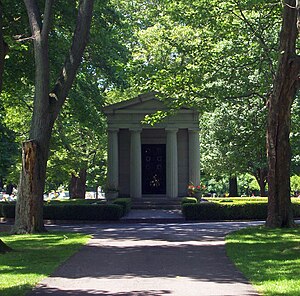Machpelah Cemetery (Le Roy, New York)

Woodward Mausoleum, east elevation, 2010
|
|
| Details | |
|---|---|
| Established | 1858 |
| Location | Le Roy, NY |
| Country | USA |
| Coordinates | 42°59′11″N 77°58′59″W / 42.98639°N 77.98306°W |
| Type | Private |
| Owned by | Machpelah Cemetery Association |
| Size | 24.7 acres (10.0 ha) |
| No. of graves | 5,500 |
| Find a Grave | Machpelah Cemetery |
Machpelah Cemetery is located on North Street in Le Roy, New York, United States. It was opened in the mid-19th century and expanded since then. Graves from other, smaller burial grounds around Le Roy have been added. It was listed on the National Register of Historic Places in 2007, one of two cemeteries in Genesee County with that distinction.
It was originally built and laid out as a rural cemetery, with a parklike setting on the banks of Oatka Creek. In the early 20th century its design philosophy changed, when a large mausoleum to local businessman Orator Francis Woodward, who in his last years made a fortune developing Jell-O into a bestselling dessert, was built in the southern section of the cemetery near his factory. The architect hired by the family to lay out the section was influenced by the City Beautiful movement, giving that area a more orderly cast.
Woodward's monument, visible from the cemetery's main entrance, is the most prominent of many notable graves in the cemetery. Other structures within include a memorial chapel built around the same time and a granite vault held together by its own weight. The markers exhibit a variety of materials, forms and styles of funerary art. Among the 5,500 dead buried here besides Woodward and his family are many people important to the history of Le Roy, including the daughters of its namesake, the inventor of Jell-O and Sarah Frances Whiting, an astronomer who was also one of the first to experiment with X-rays. Veterans of every American war lie at Machpelah as well.
The cemetery is located on a 24.7-acre (10.0 ha) parcel near the northern boundary of the village of Le Roy. Its western boundary is the irregular, curving Oatka Creek. On the south is the large, empty factory that once manufactured Jell-O when it was all produced in Le Roy. To the east, across North Street, are houses, and residential property continues to the north, into the Town of Le Roy.
A wrought iron fence runs along the south and east sides. At the three main entrances, and the southeast and northeast corners, are two limestone pillars topped with stone orbs. The southern third of the cemetery is generally flat, with axial roads radiating outward from the Woodward mausoleum near the southeast entrance. In the northern and central portions, the landscape becomes hillier, with a gentle descent to the creek. The roads there curve with the landscape. Throughout, the cemetery is planted with mature trees and shrubs from a variety of species.
...
Wikipedia
